否定句翻译
- 格式:ppt
- 大小:726.50 KB
- 文档页数:41
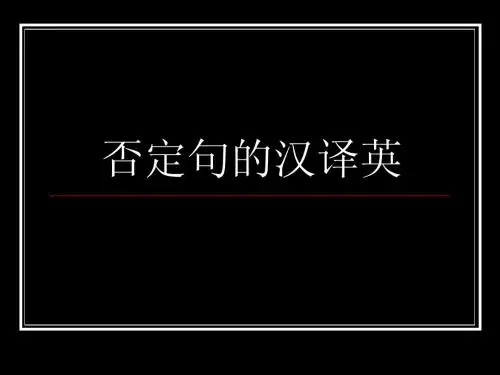

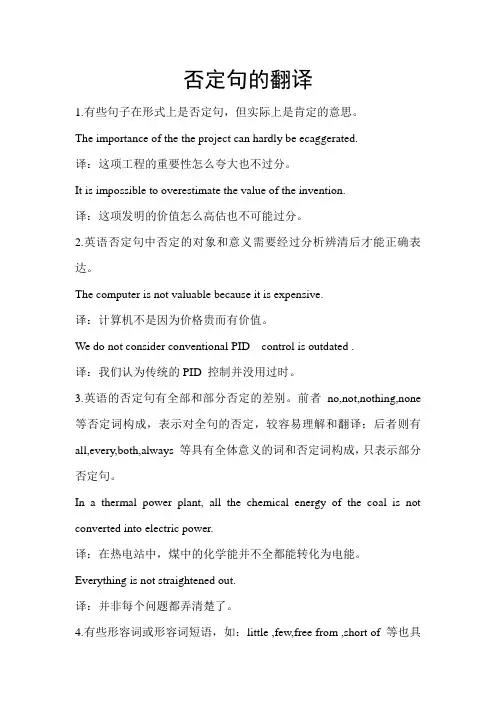
否定句的翻译1.有些句子在形式上是否定句,但实际上是肯定的意思。
The importance of the the project can hardly be ecaggerated.译:这项工程的重要性怎么夸大也不过分。
It is impossible to overestimate the value of the invention.译:这项发明的价值怎么高估也不可能过分。
2.英语否定句中否定的对象和意义需要经过分析辨清后才能正确表达。
The computer is not valuable because it is expensive.译:计算机不是因为价格贵而有价值。
We do not consider conventional PID control is outdated .译:我们认为传统的PID 控制并没用过时。
3.英语的否定句有全部和部分否定的差别。
前者no,not,nothing,none 等否定词构成,表示对全句的否定,较容易理解和翻译;后者则有all,every,both,always 等具有全体意义的词和否定词构成,只表示部分否定句。
In a thermal power plant, all the chemical energy of the coal is not converted into electric power.译:在热电站中,煤中的化学能并不全都能转化为电能。
Everything is not straightened out.译:并非每个问题都弄清楚了。
4.有些形容词或形容词短语,如:little ,few,free from ,short of 等也具有否定意义,翻译是应突出其否定的语气。
尤其注意区分little 和a little ,few和a few 的差别:little和few 通常表示否定,二a little 和a few 这通常表示可定。
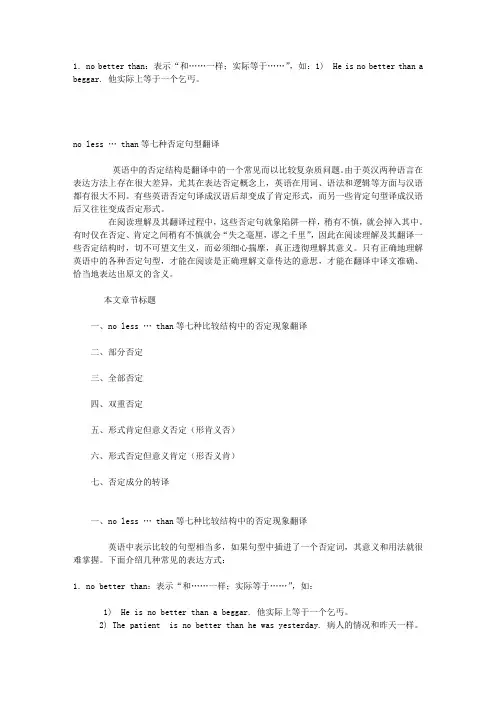
1.no better than:表示“和……一样;实际等于……”,如:1) He is no better than a beggar. 他实际上等于一个乞丐。
no less … than等七种否定句型翻译英语中的否定结构是翻译中的一个常见而以比较复杂质问题。
由于英汉两种语言在表达方法上存在很大差异,尤其在表达否定概念上,英语在用词、语法和逻辑等方面与汉语都有很大不同。
有些英语否定句译成汉语后却变成了肯定形式,而另一些肯定句型译成汉语后又往往变成否定形式。
在阅读理解及其翻译过程中,这些否定句就象陷阱一样,稍有不慎,就会掉入其中。
有时仅在否定、肯定之间稍有不慎就会“失之毫厘,谬之千里”,因此在阅读理解及其翻译一些否定结构时,切不可望文生义,而必须细心揣摩,真正透彻理解其意义。
只有正确地理解英语中的各种否定句型,才能在阅读是正确理解文章传达的意思,才能在翻译中译文准确、恰当地表达出原文的含义。
本文章节标题一、no less … than等七种比较结构中的否定现象翻译二、部分否定三、全部否定四、双重否定五、形式肯定但意义否定(形肯义否)六、形式否定但意义肯定(形否义肯)七、否定成分的转译一、no less … than等七种比较结构中的否定现象翻译英语中表示比较的句型相当多,如果句型中插进了一个否定词,其意义和用法就很难掌握。
下面介绍几种常见的表达方式:1.no better than:表示“和……一样;实际等于……”,如:1) He is no better than a beggar. 他实际上等于一个乞丐。
2) The patient is no better than he was yesterday. 病人的情况和昨天一样。
3) He has no better a say in the matter than I have.他和我一样在这件事上没有发言权。
2.not. . . any more than或no more. . . than:表示“同……一样不”,如:1) I could no more do that than you. I could not do that any more than you. 你不能做这件事,我也不能做。
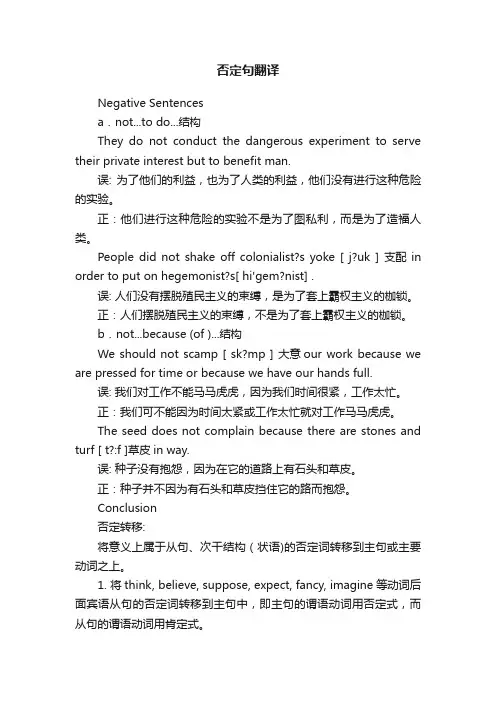
否定句翻译Negative Sentencesa.not...to do...结构They do not conduct the dangerous experiment to serve their private interest but to benefit man.误: 为了他们的利益,也为了人类的利益,他们没有进行这种危险的实验。
正:他们进行这种危险的实验不是为了图私利,而是为了造福人类。
People did not shake off colonialist?s yoke [ j?uk ] 支配in order to put on hegemonist?s[ hi'gem?nist] .误: 人们没有摆脱殖民主义的束缚,是为了套上霸权主义的枷锁。
正:人们摆脱殖民主义的束缚,不是为了套上霸权主义的枷锁。
b.not...because (of )...结构We should not scamp [ sk?mp ] 大意our work because we are pressed for time or because we have our hands full.误: 我们对工作不能马马虎虎,因为我们时间很紧,工作太忙。
正:我们可不能因为时间太紧或工作太忙就对工作马马虎虎。
The seed does not complain because there are stones and turf [ t?:f ]草皮in way.误: 种子没有抱怨,因为在它的道路上有石头和草皮。
正:种子并不因为有石头和草皮挡住它的路而抱怨。
Conclusion否定转移:将意义上属于从句、次干结构(状语)的否定词转移到主句或主要动词之上。
1. 将think, believe, suppose, expect, fancy, imagine等动词后面宾语从句的否定词转移到主句中,即主句的谓语动词用否定式,而从句的谓语动词用肯定式。
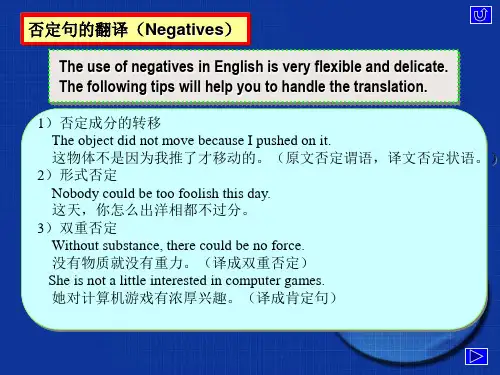

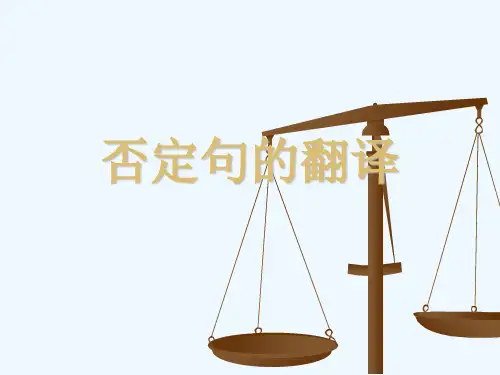
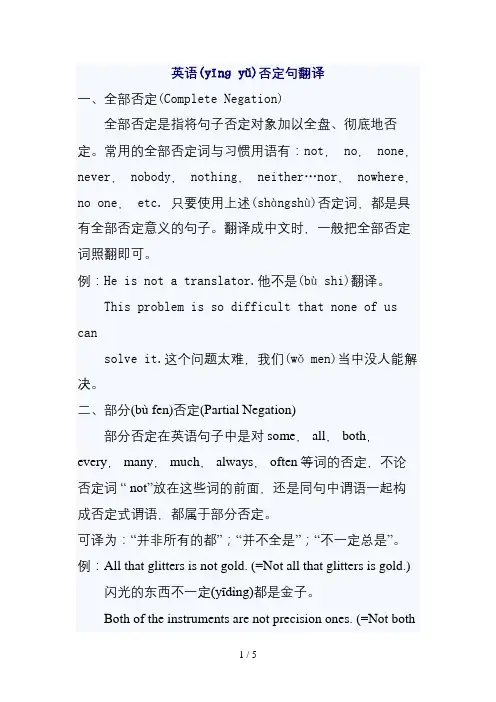
英语(yīnɡ yǔ)否定句翻译一、全部否定(Complete Negation)全部否定是指将句子否定对象加以全盘、彻底地否定。
常用的全部否定词与习惯用语有:not, no, none,never, nobody, nothing,neither…nor, nowhere,no one, etc. 只要使用上述(shàngshù)否定词,都是具有全部否定意义的句子。
翻译成中文时,一般把全部否定词照翻即可。
例:He is not a translator.他不是(bù shi)翻译。
This problem is so difficult that none of us cansolve it.这个问题太难,我们(wǒ men)当中没人能解决。
二、部分(bù fen)否定(Partial Negation)部分否定在英语句子中是对some, all, both,every, many, much, always, often等词的否定,不论否定词“ not”放在这些词的前面,还是同句中谓语一起构成否定式谓语,都属于部分否定。
可译为:“并非所有的都”;“并不全是”;“不一定总是”。
例:All that glitters is not gold. (=Not all that glitters is gold.) 闪光的东西不一定(yīdìng)都是金子。
Both of the instruments are not precision ones. (=Not bothof the instruments are precision ones.)这两台仪器(yíqì)并不都是精密仪器。
从以上两例可看出,not every=some, not both=one, not always=sometimes,not wholly=in some degree not together=somewhat.三、双重否定(Double Negation)双重否定是指两个否定词并用,否定同一个单词,或者一个否定词否定另一个否定词,其否定意义互相抵消得到肯定意义。
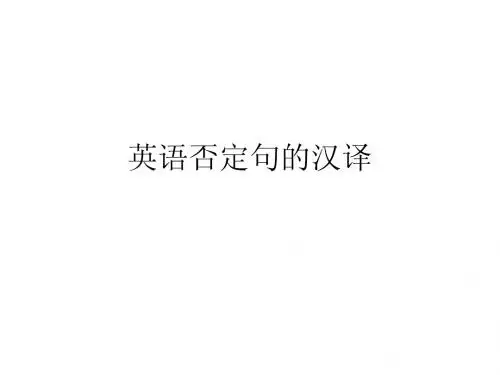

2013-03-26 11:00:14 来源:爱词霸编辑:zhouzhichao 点击:2307次英语否定句及其翻译意思否定的肯定句英语中有许多句子,形式上是肯定的,但是其意思却是否定的,这是因为英语中有许多表示否定意思的词和词组。
首先一类是所谓“准否定词,包括few, little, hardly, rarely, scarcely, barely, seldom:Few people have ever seen him get out of that house. 几乎没什么人看见他从那间屋子里出来过。
He has seen little of life.。
他不懂什么世故(没有见过什么世面)。
I can hardly read the original without a dictionary. 不借助于词典我简直看不懂原著。
People rarely see this kind of plant in blossom. 人们很少见到过(几乎没有见到过)这种植物开花。
We scarcely ever need it; take it away.我们极难得需要它(几乎用不着它);把它拿走。
需要注意的是,英语里一般都用这类“准否定词”表示“几乎不”的意思,而不说almost not.其次,英语中有许多动词含有否定的意思。
请看下列例句:The door simply refused to open.门根本就打不开。
The error of calculation escaped the accountant. 会计没有注意到这一计算错误。
He ignored the whole speech of the schoolmaster. 他根本就没有听校长的讲话。
The boy tried by every means to avoid being caught by his father. 那孩子想方设法不让父亲逮住他。
英汉翻译否定句式的翻译l 就词汇而言,英语中表示否定的词比汉语多,按词分类,有名词、代词、动词、形容词、副词、连词等;从意义上分类,有完全否定、部分否定、含蓄否定、双重否定以及其他否定形式等。
就表达方式而言,有用单词或词组表示的,也有用特殊结构表示的。
l 例如,not 和 no 都表示否定,但在否定句中有时候意思却同:l 1. She is not a dancer.l 她不是个舞蹈家。
l 2. She is no dancer.l 她算不上个舞蹈家。
(她跳舞还可以,但还达不到舞蹈家的水平)l 3. It is not easy task.l 这不是一件容易的事。
l 4. It is no easy task.l 这可不是一件轻而易举的事。
(主观上的强调)l 5. It is not a joke.l 这不是玩笑。
l 6. It is no joke.l 这决不是开玩笑的事情。
(着重强调这是件很正经的事)一、完全否定l 英语表示完全否定的词有 no, not, never, none, nobody, nothing, nowhere, neither…nor等。
含有这些词的完全否定句一般情况下意思都是一目了然,只要注意译文的表达,符合现代汉语的习惯就行了。
l None of the answers are right.l 这些答案都不对。
l Matter can neither be created nor be destroyed.l 物质即不能创造又无法消灭。
l He has nothing to do with the matter.l 他和这件事毫无关系。
二、部分否定l 部分否定就是指整个句子所表达的意义或概念不是全部否定,而是既含有部分否定的意思,也含有部分肯定的意思。
部分否定句式常常译为“不都……” “并非……”。
l --所有的问题在会上都没有解决。
l --All of the problems were not solved at meeting. = Not all of the problems were solved …= Some of the problems were solved, but some are not… (错译)l --None of the problems were solved at the meeting.l 注意区分完全否定和部分否定,才能避免翻译上的错误。